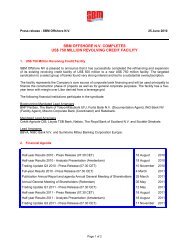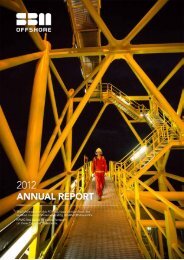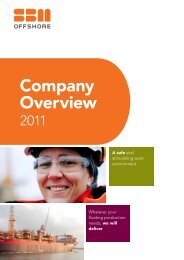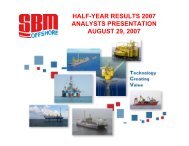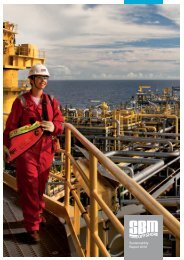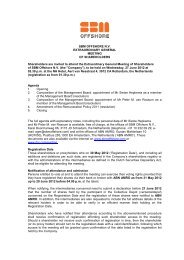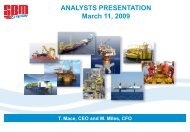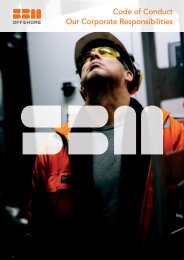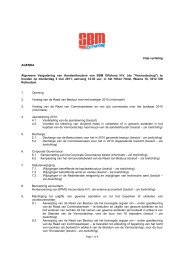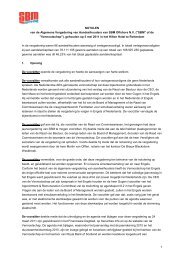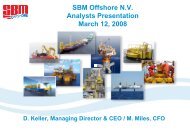Annual Report 2010 - SBM Offshore
Annual Report 2010 - SBM Offshore
Annual Report 2010 - SBM Offshore
You also want an ePaper? Increase the reach of your titles
YUMPU automatically turns print PDFs into web optimized ePapers that Google loves.
Lease income is, as of the commencement date of the<br />
lease contract, recognised over the term of the lease<br />
using the net investment method, which reflects a<br />
constant periodic rate of return. During the construction<br />
period of the facility, the contract is treated as a<br />
construction contract, whereby the stage of completion<br />
method is applied.<br />
When assets are leased out under an operating lease,<br />
the asset is included in the balance sheet based on<br />
the nature of the asset. Lease income from operating<br />
leases is recognised over the term of the lease on<br />
a straight line basis. This implies the recognition of<br />
deferred income in the balance sheet when the contractual<br />
dayrates are not constant during the original<br />
term of the lease contract.<br />
Property, plant and equipment<br />
Property, plant and equipment is stated at historical<br />
cost less accumulated depreciation and impairment,<br />
with the exception of land, which is shown at cost less<br />
impairment. Historical cost includes expenditure that<br />
is directly attributable to the acquisition of such items.<br />
The capital value of a facility to be leased and operated<br />
for a client is the sum of external costs (such as<br />
shipyards, subcontractors, suppliers), internal costs<br />
(design, engineering, construction supervision, etc.),<br />
third party financial costs including interest paid during<br />
construction and attributable overheads.<br />
Subsequent costs are included in the asset’s carrying<br />
amount or recognised as a separate asset, as appropriate,<br />
only when it is probable that future economic<br />
benefits associated with the item will flow to the<br />
Company and the cost of the item can be measured<br />
reliably. The costs of assets include the initial estimate<br />
of costs of demobilisation of the asset. All other<br />
repairs and maintenance are charged to the income<br />
statement during the financial period in which they<br />
are incurred.<br />
The assets are depreciated by using the straight-line<br />
method over their anticipated useful life, taking into<br />
account a residual value for the vessels and floating<br />
equipment, with the exception of the ThunderHawk<br />
facility. The depreciation charge for the ThunderHawk<br />
facility is calculated based on its future anticipated<br />
economic benefits. This results in a depreciation<br />
charge partly based on the units of production method<br />
and for the other part based on the straight line<br />
method. Investment subsidies (with the exception of<br />
investment premiums) are directly deducted from the<br />
historical costs of the assets.<br />
The anticipated useful lives of the categories of<br />
property, plant and equipment are as follows:<br />
Land and Buildings (Unless unlimited lives) 30-50 years<br />
Vessels and floating equipment<br />
- converted tankers, including refurbishment;<br />
-'non-recoverable' investments<br />
costs which are incurred for a specific project, e.g. installation costs, transport costs,costs of anchor lines, anchor points, risers<br />
etc., are depreciated over the period of the contract to which they relate;<br />
- investments in facilities<br />
which include the mooring system, swivel stack, vessel conversion, process equipment if relevant etc. In case of long-term<br />
contracts these items are fully depreciated over the contract duration, For shorter-term contracts, a decision is taken as to<br />
which percentage of these costs should be depreciated.<br />
Machinery and equipment<br />
Other fixed assets<br />
Financial Review / Financial Statements <strong>2010</strong><br />
10-20 years<br />
3-15 years<br />
3-15 years<br />
5-20 years<br />
2-20 years<br />
<strong>SBM</strong> <strong>Offshore</strong> – <strong>Annual</strong> <strong>Report</strong> <strong>2010</strong> 119



